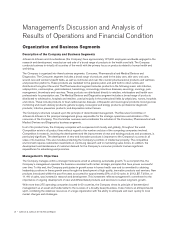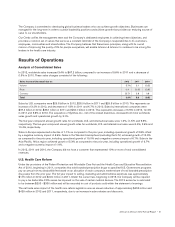Johnson and Johnson 2012 Annual Report Download - page 20
Download and view the complete annual report
Please find page 20 of the 2012 Johnson and Johnson annual report below. You can navigate through the pages in the report by either clicking on the pages listed below, or by using the keyword search tool below to find specific information within the annual report.approximately $2.4 billion as of January 1, 2012. Approximately $1.2 billion as of December 30, 2012 and approximately
$1.4 billion as of January 1, 2012 of the Southern European Region net trade accounts receivable balance related to the
Company’s Consumer, Vision Care and Diabetes Care businesses as well as certain Pharmaceutical and Medical Devices
and Diagnostics customers which are in line with historical collection patterns.
The remaining balance of net trade accounts receivable in the Southern European Region has been negatively impacted
by the timing of payments from certain government owned or supported health care customers as well as certain
distributors of the Pharmaceutical and Medical Devices and Diagnostics local affiliates. The total net trade accounts
receivable balance for these customers were approximately $0.9 billion at December 30, 2012 and $1.0 billion at
January 1, 2012. The Company continues to receive payments from these customers and in some cases late payment
premiums. For customers where payment is expected over periods of time longer than one year, revenue and trade
receivables have been discounted over the estimated period of time for collection. Allowances for doubtful accounts have
been increased for these customers, but have been immaterial to date. The Company will continue to work closely with
these customers on payment plans, monitor the economic situation and take appropriate actions as necessary.
Financing and Market Risk
The Company uses financial instruments to manage the impact of foreign exchange rate changes on cash flows.
Accordingly, the Company enters into forward foreign exchange contracts to protect the value of certain foreign currency
assets and liabilities and to hedge future foreign currency transactions primarily related to product costs. Gains or losses
on these contracts are offset by the gains or losses on the underlying transactions. A 10% appreciation of the U.S. Dollar
from the December 30, 2012 market rates would increase the unrealized value of the Company’s forward contracts by
$91 million. Conversely, a 10% depreciation of the U.S. Dollar from the December 30, 2012 market rates would decrease
the unrealized value of the Company’s forward contracts by $112 million. In either scenario, the gain or loss on the forward
contract would be offset by the gain or loss on the underlying transaction, and therefore, would have no impact on future
anticipated earnings and cash flows.
The Company hedges the exposure to fluctuations in currency exchange rates, and the effect on certain assets and
liabilities in foreign currency, by entering into currency swap contracts. A 1% change in the spread between U.S. and
foreign interest rates on the Company’s interest rate sensitive financial instruments would either increase or decrease the
unrealized value of the Company’s swap contracts by approximately $190 million. In either scenario, at maturity, the gain or
loss on the swap contract would be offset by the gain or loss on the underlying transaction, and therefore, would have no
impact on future anticipated cash flows.
The Company does not enter into financial instruments for trading or speculative purposes. Further, the Company has a
policy of only entering into contracts with parties that have at least an “A” (or equivalent) credit rating. The counter-parties
to these contracts are major financial institutions and there is no significant concentration of exposure with any one
counter-party. Management believes the risk of loss is remote.
The Company has access to substantial sources of funds at numerous banks worldwide. In September 2012, the
Company secured a new 364-day Credit Facility. Total credit available to the Company approximates $10 billion, which
expires on September 19, 2013. Interest charged on borrowings under the credit line agreement is based on either bids
provided by banks, the prime rate or London Interbank Offered Rates (LIBOR), plus applicable margins. Commitment fees
under the agreement are not material.
Total borrowings at the end of 2012 and 2011 were $16.2 billion and $19.6 billion, respectively. The reduction in debt in
2012 of approximately $3.4 billion was primarily due to a reduction in commercial paper.
In 2012, net cash (cash and current marketable securities, net of debt) was $4.9 billion compared to net cash of
$12.6 billion in 2011. Total debt represented 20.0% of total capital (shareholders’ equity and total debt) in 2012 and
25.6% of total capital in 2011. Shareholders’ equity per share at the end of 2012 was $23.33 compared to $20.95 at
year-end 2011, an increase of 11.4%.
A summary of borrowings can be found in Note 7 to the Consolidated Financial Statements.
12 •Johnson & Johnson 2012 Annual Report
























